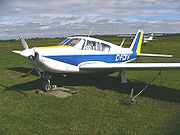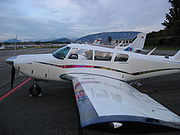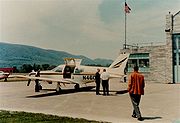
Piper PA-24 Comanche
Encyclopedia



Monocoque
Monocoque is a construction technique that supports structural load by using an object's external skin, as opposed to using an internal frame or truss that is then covered with a non-load-bearing skin or coachwork...
construction with retractable landing gear
Undercarriage
The undercarriage or landing gear in aviation, is the structure that supports an aircraft on the ground and allows it to taxi, takeoff and land...
that was first flown in May 1956 according to a Piper Aircraft Company press release. Together with the Twin Comanche, it made up the core of the Piper Aircraft line-up until 1972, when the production lines for both aircraft were wiped out in a flood.
Development
Comanche production began in 1957 with the PA-24-180 model. The PA-24-250 model was added in 1958, powered by a Lycoming O-540-A1A5Lycoming O-540
|-Specifications :-See also:-External links:...
engine. In 1963 the 400 hp PA-24-400 was introduced. The following year, the PA-24-250 was superseded by the PA-24-260, featuring the Lycoming IO-540D or E engine of 260 hp. The 260 was also available as the Turbo Comanche C with a Rajay turbocharger and was introduced in 1970.
Production of the Comanche ended in 1972
1972 in aviation
This is a list of aviation-related events from 1972:- Events :* Early in the year, the United States introduces the Walleye II optically guided glide bomb into service, employing it in the Vietnam War. It becomes known as the "Fat Albert."-January:...
when torrential rains from Hurricane Agnes
Hurricane Agnes
Hurricane Agnes was the first tropical storm and first hurricane of the 1972 Atlantic hurricane season. A rare June hurricane, it made landfall on the Florida Panhandle before moving northeastward and ravaging the Mid-Atlantic region as a tropical storm...
caused the great Susquehanna River flood of 1972, flooding the manufacturing plant and destroying airframes, parts, and much of the tooling necessary for production. Rather than re-build the tooling, Piper chose to abandon production of the Comanche and Twin Comanche, and continue with two newer designs already in production at Piper's other plant in Vero Beach, Florida
Vero Beach, Florida
Vero Beach is a city in Indian River County, Florida, USA. According to the U.S. Census Bureau's 2006 estimates, the city had a population of 16,939. It is the county seat of Indian River County...
: the twin engine PA-34 Seneca
Piper PA-34 Seneca
The Piper PA-34 Seneca is an American twin-engined light aircraft, produced by Piper Aircraft since 1971 and still in production in 2011.The Seneca is primarily used for personal and business flying.-Development:...
and the PA-28R-200 Arrow
Piper Cherokee
The Piper PA-28 Cherokee is a family of light aircraft designed for flight training, air taxi, and personal use. It is built by Piper Aircraft....
.
At that time Piper had already begun to concentrate on its successful Piper PA-28 Cherokee line, which had originally been conceived as a cheaper alternative to the Comanche. The Arrow was a retractable gear version of the popular Cherokee trainer; its smaller 200 hp engine was less expensive and easier to fly than the Comanche; sales of the single engine Comanche had faltered after the introduction of the Arrow in 1967.
The Comanche production run ended with the disposal of all of the tooling, and completion of the last seven airframes. After the Susquehanna River receded, Piper moved the last aircraft to Vero Beach and completed construction there. The self-described junior member of the completion team was Chuck Suma, who 30 years later would become the CEO of The New Piper Aircraft, Inc.
Comanche 180
The original version of the Comanche was the PA-24, which featured a carbureted 180 hp (134 kW) Lycoming O-360-A1A engine, swept tail, laminar flowLaminar flow
Laminar flow, sometimes known as streamline flow, occurs when a fluid flows in parallel layers, with no disruption between the layers. At low velocities the fluid tends to flow without lateral mixing, and adjacent layers slide past one another like playing cards. There are no cross currents...
airfoil, and all-flying stabilator
Stabilator
A stabilator is an aircraft control surface that combines the functions of an elevator and a horizontal stabilizer...
. Designed by Howard "Pug" Piper, the new Comanche was intended to compete in the market with the very successful Beechcraft Bonanza
Beechcraft Bonanza
The Beechcraft Bonanza is an American general aviation aircraft introduced in 1947 by The Beech Aircraft Corporation of Wichita, Kansas. , it is still being produced by Hawker Beechcraft, and has been in continuous production longer than any other airplane in history...
.
The initial production run of the 180 hp Comanche singles were given the PA-24 type designation. The remainder of this production run were given the PA24-180 designation.
The standard fuel capacity of the PA-24-180 was 60 gallons (227.1 l). The flaps were manually actuated, controlled by the same Johnson bar
Johnson bar
A Johnson bar is a hand lever with several distinct positions and a positive latch to hold the lever in the selected position. The latch is typically activated with a spring-loaded squeeze handle on the lever so that only one hand is needed to release the latch, move the lever, then re-engage the...
actuator as the Piper Cherokee
Piper Cherokee
The Piper PA-28 Cherokee is a family of light aircraft designed for flight training, air taxi, and personal use. It is built by Piper Aircraft....
. The aircraft specifications were for cruise speeds of 116 to 139 knots (272.4 km/h) and fuel burns between 7.5 and 10.5 gph at 55-percent and 75-percent power settings. Full-fuel payload with standard fuel was 715 pounds, with a gross weight of 2550 lb (1,156.7 kg) and range with 45-minute reserve of 700 nautical mile
Nautical mile
The nautical mile is a unit of length that is about one minute of arc of latitude along any meridian, but is approximately one minute of arc of longitude only at the equator...
s.
When new, standard, average-equipped Comanche 180s sold between $17,850 (1958) and $21,580 (1964). A total of 1,143 were built.
Comanche 250
In 1958 Piper introduced a 250 horsepower (186 kW) version using a Lycoming O-540Lycoming O-540
|-Specifications :-See also:-External links:...
engine, giving the PA-24-250 Comanche a top cruise speed of 160 kts (185 mph; 298 km/h). Most 250s had carbureted Lycoming O-540-AIA5 engines, but a small number were fitted out with fuel-injected versions of the same engine. Early Comanche 250s had manually-operated flaps and carried 60 gallons (227.1 l) of fuel. Auxiliary fuel tanks (90 gallons (340.7 l) total) became available in 1961. Electrically actuated flaps were made standard with the 1962 model year. The aircraft's gross weight was increased from 2,800 pounds to 2,900 pounds in 1961, making the useful load 1,270 pounds.
The Comanche 250 advertised cruise speeds of 140-157 knots and fuel burns of 10-14 gph (55% and 75% power).
Prices of new Comanche 250s ranged from $21,250 (1958) to $26,900, which was only $3,000 to $5,000 more expensive than the Comanche 180. Some 2,537 were sold.
Comanche 260
In 1965 the first of four 260 horsepower (194 kW) versions of the Comanche was introduced. They were:- PA-24-260 (1965)
- PA-24-260B (1966 to 1968)
- PA-24-260C (1969 to 1972)
- PA-24-260TC
A total of 1,029 airplanes were sold from the Comanche 260 line, including the 260TC. 38 Comanche 260s were delivered with carbureted engines; the rest used the fuel-injected Lycoming IO-540
Lycoming O-540
|-Specifications :-See also:-External links:...
engine.
The 260 had an empty weight of approximately 1,700 pounds and a max gross weight of 2,900 pounds. It had four seats and a 90 gallons (340.7 l)-capacity auxiliary fuel system was available as an option. Cruise speed was advertised as 142-161 knots with fuel burn of 10-14 gallons (53 l) per hour. New, they sold for approximately $30,740.
The 260B had an overall length six inches (152 mm) more than the previous models. This was due to a longer prop spinner, not a longer fuselage. The 260B had a third side window and a provision for six seats. The fifth and sixth seats are suitable only for children and take up the entire baggage compartment. Typical empty weight was 1728 pounds and gross weight was 3,100 pounds. Fuel burn was 11-14 gallons (53 l) per hour and advertised speed was 140-160 knots. New, they sold for $32,820 to $33,820.
The 260C introduced a new "Tiger Shark" cowling, max gross weight of 3200 pounds, cowl flaps, and an aileron-rudder interconnect. Cruise speed was advertised as 150-161 knots with fuel flow of 12.5-14.1 gallons (53.4 l) per hour. To prevent possible aft center of gravity problems due to the increased gross weight and its fifth and sixth seats, the propeller shaft was extended. This moved the center of gravity slightly forward. With a useful load of 1427 pounds it has the largest payload of all of the Comanches except the 400. Often mistaken on the ramp for the 400 model, the slightly longer cowling includes a distinctively longer nose gear door, as compared to the B models and older versions. New, they sold for $36,550 to $45,990.
Comanche 260TC (turbo)
The 260-TC (1970 to 1972) had a turbo normalizing system of dual manually controlled Rajay turbochargers. These were controlled by what Piper called a "second throttle" on the power quadrant. This manually controlled turbocharger was used by first using throttle to bring manifold pressure up to the desired level. If conditions are such that insufficient manifold pressure is developed for the task at hand, then the pilot would begin closing the turbo's wastegate by moving the turbocharger lever forward.Comanche 400
The PA-24-400 Comanche 400, while identical in planform to other single-engined Comanches, is structurally strengthened, primarily in the tail. The aircraft has an extra nose rib in the stabilator and in the vertical fin. The stabilator, vertical fin, and rudder of the 400 share virtually no common parts with the 180, 250, and 260 hp Comanches. In addition, the 400's rudder is aerodynamically balanced in a manner similar to that of the Piper PA-30 Twin Comanche and does not have the lead external balance weights of the lower-powered single-engine Comanches.The Comanche 400 is powered by the 400 horsepower
Horsepower
Horsepower is the name of several units of measurement of power. The most common definitions equal between 735.5 and 750 watts.Horsepower was originally defined to compare the output of steam engines with the power of draft horses in continuous operation. The unit was widely adopted to measure the...
8-cylinder Lycoming IO-720 engine, an engine developed specifically for the Comanche.
Only 148 PA-24-400s were built. The aircraft's high fuel burn means that it is expensive to operate and there have been cooling problems with the rear cylinders of the horizontally-opposed eight cylinder engine. Even with the huge engine the PA-24-400 only manages a top speed of 194 knots (360 km/h) and cruising speed of 185 knots (343 km/h), considerably slower than more modern light aircraft, like the Cessna 400, operating with much less horsepower.
The Comanche 400 has a three-blade propeller and carries 100 gallons (378.5 l) of fuel, or 130 gallons (492.1 l) with optional extended tanks. Fuel burn was advertised as 16-23 gallons (87.1 l) per hour, at 55%-75% power. The 400 had a typical empty weight of 2,110 pounds and a max gross weight of 3,600 pounds. New base price for 1964 was $28,750 according to PIPER AIRCRAFT by Roger W. Peperell.
PA-33
In 19671967 in aviation
This is a list of aviation-related events from 1967:- Events :* The Canadian Golden Centennaires aerobatic team is formed and performs all year to celebrate the Canadian centennial year....
a single Comanche was modified by Edward Swearingen to pressurize the cabin. The prototype was designated the PA-33, but Piper decided not to put the aircraft into production. The one prototype PA-33 was scrapped following a taxiing accident. The exterior design of the PA-33 was later used as a basis for the Piper Malibu.
Max Conrad
In June 19591959 in aviation
This is a list of aviation-related events from 1959:- Events :* The Canadian Golden Hawks aerobatic team is formed.* The United States Department of the Navy merges its Bureau of Aeronautics and Bureau of Ordnance to form a new Bureau of Naval Weapons....
Max Conrad
Max Conrad
Maximilien "Max" Conrad, known as the "Flying Grandfather", was a record-setting aviator. In the 1950s and 1960s, he set nine official light plane world records, three of which still stand at the end of 2008. For his efforts, he was awarded the Louis Blériot medal in 1952 and the prestigious...
flew a Comanche 250 on a record-breaking distance flight in Fédération Aéronautique Internationale
Fédération Aéronautique Internationale
The Fédération Aéronautique Internationale is the world governing body for air sports and aeronautics and astronautics world records. Its head office is in Lausanne, Switzerland. This includes man-carrying aerospace vehicles from balloons to spacecraft, and unmanned aerial vehicles...
C1-D Class, for aircraft between 3858 lb (1,750 kg) to less than 6614 lb (3,000 kg). Having removed the interior seats and replaced them with fuel tanks, Conrad flew non-stop from Casablanca
Casablanca
Casablanca is a city in western Morocco, located on the Atlantic Ocean. It is the capital of the Grand Casablanca region.Casablanca is Morocco's largest city as well as its chief port. It is also the biggest city in the Maghreb. The 2004 census recorded a population of 2,949,805 in the prefecture...
, Morocco
Morocco
Morocco , officially the Kingdom of Morocco , is a country located in North Africa. It has a population of more than 32 million and an area of 710,850 km², and also primarily administers the disputed region of the Western Sahara...
to Los Angeles
Los Ángeles
Los Ángeles is the capital of the province of Biobío, in the commune of the same name, in Region VIII , in the center-south of Chile. It is located between the Laja and Biobío rivers. The population is 123,445 inhabitants...
, a distance of 7668 mi (12,340 km). When the aircraft took off from Casablanca, it was heavily overloaded and just cleared the airport fence. The Comanche 250 which Max Conrad flew for this flight is now located in the museum at the Liberal, Kansas
Liberal, Kansas
Liberal is the county seat of Seward County, Kansas, United States. As of the 2010 census, the city population was 20,525.- History :S.S. Rogers built the first house in what would become Liberal in 1872. Rogers became famous in the region for giving water to weary travelers...
airport.
On November 24, 1959 Conrad flew a Comanche 180 on a record flight in FAI C1-C Class for aircraft taking off at weights between 2204 lb (1,000 kg) to less than 3858 lb (1,750 kg)), that still stands: Casablanca to El Paso, Texas
El Paso, Texas
El Paso, is a city in and the county seat of El Paso County, Texas, United States, and lies in far West Texas. In the 2010 census, the city had a population of 649,121. It is the sixth largest city in Texas and the 19th largest city in the United States...
6966 mi (11,211 km) non-stop.
Myth Too
A Comanche named Myth Too and registered G-ATOY was owned by the English aviatrix Sheila ScottSheila Scott
Sheila Scott OBE , was an English aviatrix.Born Sheila Christine Hopkins in Worcester, Worcestershire, England in 1922, educated at the Alice Ottley School, she broke over 100 aviation records through her long distance flight endeavours, which included a "world and a half" flight in 1971...
. The aircraft holds ninety world class light aviation records. It is on public display at the National Museum of Flight, Scotland.
Accidents
Country music singers Patsy ClinePatsy Cline
Patsy Cline , born Virginia Patterson Hensley in Gore, Virginia, was an American country music singer who enjoyed pop music crossover success during the era of the Nashville sound in the early 1960s...
, "Cowboy" Lloyd Copas
Cowboy Copas
Lloyd Estel Copas , known by his stage name Cowboy Copas, was an American country music singer popular from the 1940s until his death in the 1963 plane crash that also killed country stars Patsy Cline and Hawkshaw Hawkins. He was a member of the Grand Ole Opry.-Biography:Copas was born in 1913 in...
and Hawkshaw Hawkins
Hawkshaw Hawkins
Harold Franklin Hawkins , better known as Hawkshaw Hawkins, was an American country music singer popular from the 1950s into the early 60s known for his rich, smooth vocals and music drawn from blues, boogie and honky tonk...
were on board a Comanche owned and piloted by Cline's manager, Randy Hughes, when it crashed in deteriorating weather near Camden, Tennessee
Camden, Tennessee
Camden is a city in Benton County, Tennessee, United States. The population was 3,828 at the 2000 census. It is the county seat of Benton County.-Geography:Camden is positioned at...
on 5 March 1963, killing all on board.
Specifications (PA-24-260)

External links
- The International Comanche Society
- "The Comanche Story" history of the Comanche models

